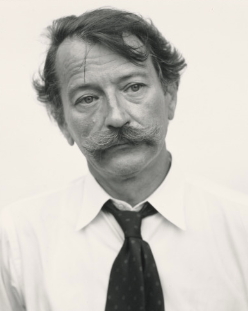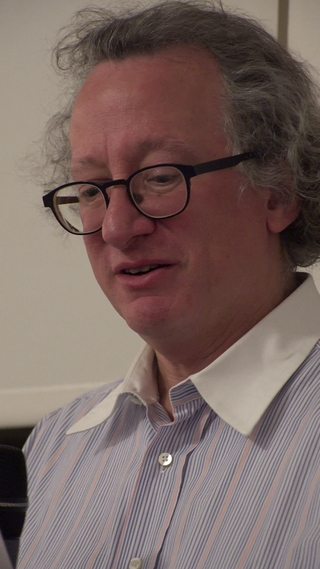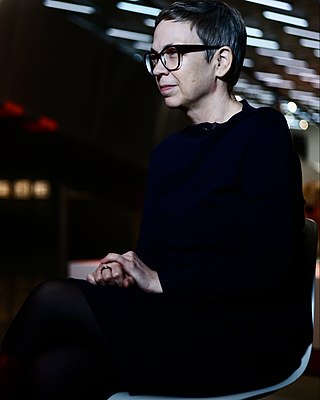
Eugène Atget was a French flâneur and a pioneer of documentary photography, noted for his determination to document all of the architecture and street scenes of Paris before their disappearance to modernization. Most of his photographs were first published by Berenice Abbott after his death. Though he sold his work to artists and craftspeople, and became an inspiration for the surrealists, he did not live to see the wide acclaim his work would eventually receive.

Thaddeus John Szarkowski was an American photographer, curator, historian, and critic. From 1962 to 1991 Szarkowski was the director of photography at New York's Museum of Modern Art (MoMA).
Martha Rosler is an American artist. She is a conceptual artist who works in photography and photo text, video, installation, sculpture, site-specific and performance, as well as writing about art and culture. Rosler's work is centered on everyday life and the public sphere, often with an eye to women's experience. Recurrent concerns are the media and war, as well as architecture and the built environment, from housing and homelessness to places of passage and systems of transport.

Artforum is an international monthly magazine specializing in contemporary art. The magazine is distinguished from other magazines by its unique 10½ × 10½ inch square format, with each cover often devoted to the work of an artist. Notably, the Artforum logo is a bold and condensed iteration of the Akzidenz-Grotesk font, a feat for an American publication to have considering how challenging it was to obtain fonts favored by the Swiss school via local European foundries in the 1960s. Artforum is published by Artforum Media, LLC, a subsidiary of Penske Media Corporation.

Linda Nochlin was an American art historian, Lila Acheson Wallace Professor Emerita of Modern Art at New York University Institute of Fine Arts, and writer. As a prominent feminist art historian, she became well known for her pioneering 1971 article "Why Have There Been No Great Women Artists?" published by ARTnews.
Rirkrit Tiravanija is a Thai contemporary artist residing in New York City, Berlin, and Chiangmai, Thailand. He was born in Buenos Aires, Argentina in 1961. His installations often take the form of stages or rooms for sharing meals, cooking, reading or playing music; architecture or structures for living and socializing are a core element in his work.
The Peace Tower was a collaborative artwork spearheaded by the artists Irving Petlin and Mark di Suvero. The Peace Tower was created in the winter of 1966 in the West Hollywood neighborhood of Los Angeles to protest US involvement in the Vietnam War. Forty years later, Mark di Suvero, Irving Petlin, and Rirkrit Tiravanija collaborated in revisiting the project through a new installation entitled Peace Tower (2006) for the Whitney Museum of American Art in New York City to protest the Iraq War.
The Getty Foundation, based in Los Angeles, California at the Getty Center, awards grants for "the understanding and preservation of the visual arts". In the past, it funded the Getty Leadership Institute for "current and future museum leaders", which is now at Claremont Graduate University. Its budget for 2006–07 was $27.8 million. It is part of the J. Paul Getty Trust.
Relational art or relational aesthetics is a mode or tendency in fine art practice originally observed and highlighted by French art critic Nicolas Bourriaud. Bourriaud defined the approach as "a set of artistic practices which take as their theoretical and practical point of departure the whole of human relations and their social context, rather than an independent and private space." The artist can be more accurately viewed as the "catalyst" in relational art, rather than being at the centre.

Anton Vidokle is an artist and founder of e-flux. Born in 1965, Vidokle lives in New York and Berlin.
Thomas Kellein is a German art historian; gallery director; author; and curator. He was the Director at Kunsthalle Basel between 1988 and 1995, and the Director of the Kunsthalle Bielefeld between 1996 and 2010. He was the Director of the Chinati Foundation between 2011 and 2012.

Barry Schwabsky is an American art critic, art historian and poet. He has taught at the School of Visual Arts, Pratt Institute, New York University, Yale University, and Goldsmiths College, among others.
Gavin Brown is a British artist and art dealer. He is the owner of the gallery, Gavin Brown's enterprise in New York City and co-founder of non-profit gallery 356 Mission in Los Angeles. The 356 Mission art space closed in 2019, due to the lease ending.
Karen Archey is an American art critic and curator based in New York City and Amsterdam. She is the Curator of Contemporary Art and Time-Based Media at Stedelijk Museum in Amsterdam, and the former editor of e-flux.
Alicia Eler is a visual art critic and reporter at the Star Tribune in Minneapolis. Eler's cultural criticism and reporting are published in The Guardian, Glamour, New York magazine, CNN, LA Weekly, Chicago Tribune, Chicago Sun-Times, New Inquiry, Hyperallergic, Aperture, MAXIM, Art21 Magazine, and Artforum.
Rachel Rose is an American visual artist known for her video installations. Her work explores how our changing relationship to landscape has shaped storytelling and belief systems. She draws from, and contributes to, a long history of cinematic innovation, and through her subjects—whether investigating cryogenics, 17th century agrarian England, the American Revolutionary War, modernist architecture, or the sensory experience of walking in outer space—she questions what it is that makes us human and the ways we seek to alter and escape that designation.
Joseph Grigely is an American visual artist and scholar. His work is primarily conceptual and engages a variety of media forms including sculpture, video, and installations. Grigely was included in two Whitney Biennials, and is also a Guggenheim Fellow. He lives and works in Chicago, where he is Professor of Visual and Critical Studies at the School of the Art Institute of Chicago.
Aria Dean is an American artist, critic, and curator. Until 2021, Dean served as Curator and Editor of Rhizome. Her writings have appeared in various art publications including Artforum, e-flux, The New Inquiry, Art in America, and Topical Cream. Dean has exhibited internationally at venues such as Foxy Production and American Medium in New York, Chateau Shatto in Los Angeles, and Arcadia Missa in London. Dean also co-directs As It Stands LA, an artists project space that opened in 2015. Dean lives and works in New York City and Los Angeles. She is represented by Greene Naftali.

Barbara Steiner is an Austrian art historian, curator, author, and editor. Steiner is the director of the Bauhaus Dessau Foundation. She served as the director of the Galerie für Zeitgenössische Kunst Leipzig from 2001 to 2011, and as the director of Kunsthaus Graz from 2016 to 2021.
David Velasco is an American editor. He was the editor-in-chief of the art magazine Artforum from 2017 to 2023. He is the editor of Modern Dance, a 2017 series of books on contemporary choreographers published by the Museum of Modern Art, New York. He has written texts on a number of artists, including Sarah Michelson, Adrian Piper, and David Wojnarowicz. In 2017, he assisted photographer and activist Nan Goldin establish the activist group P.A.I.N., chronicled in Laura Poitras's Academy Award–nominated documentary All the Beauty and the Bloodshed (2022).







